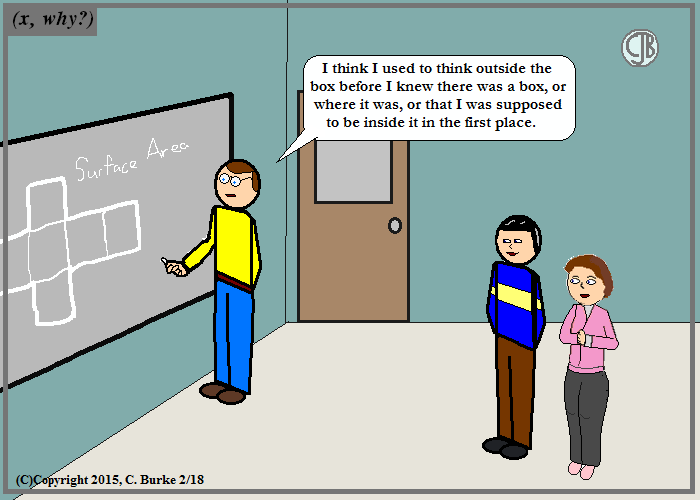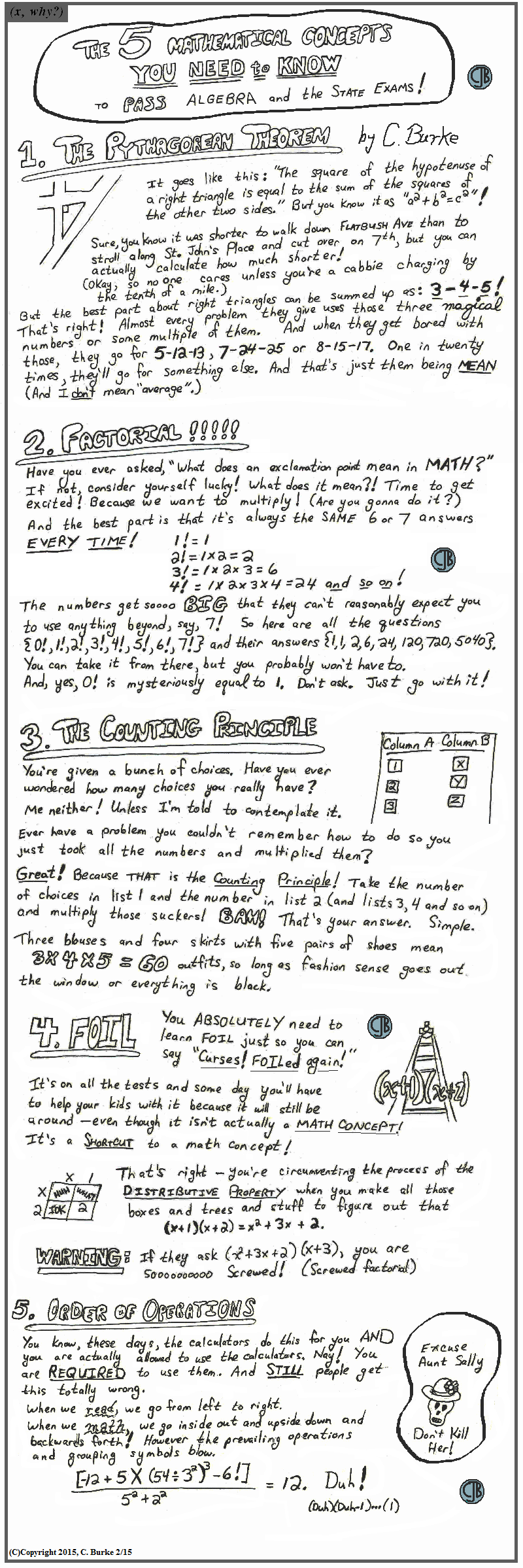If you find this page helpful, please Like or Share or Leave a Comment. Thank you!
Apologies for the delay: snow, a new job assignment, more snow, and the craziest with the testing. If anyone's still interested, here are the answers for the multiple-choice. Images will be added later. I still have to scan in some work for Part IV.
1. If A = {1, 2, 3, 4, 5, 6, 7, 8} and B = {2, 4, 6, 8, 10, 12}, the intersection of sets A and B is …
The intersection is comprised of the elements which appear in both sets. In this case {2, 4, 6, 8}.
2. What is the value of n in the equation 0.2(n – 6) = 2.8?
Work it out algebraically or work backward from the choices. It’s 20. You could either use the Distributive Property, or just divide both sides by 0.2.
3. The expression (24x6y3)/(-6x3y) is equivalent to …
Divide the coefficients and subtract the exponents: -4x3y2.
4. Which situation is represented by bivariate data?
“Bivariate” refers to two variables. The ice cream measuring temperature and sales is measuring two variables.
5. A cylinder has a circular base with a radius of 3 units and a height of 7 units. What is the volume of the cylinder in cubic units?
V = (pi)r2h = (pi)(3)2(7) = 63pi.
6. The graph of f(x) is shown below.
Based on this graph, what are the roots of the equation for f(x) = 0?
For what values of x is the function equal to 0? What are the roots of the function? Where does it cross the x-axis? At -1 and 5.
7. Jose wants to ride his bike a total of 50 miles this weekend. If he rides m miles on Saturday, which expression represents the number of miles he must ride on Sunday?
He rides whatever is left. Subtract 50 – m.
8. Four students are playing a math game at home. One of the math game questions asked them to write an algebraic equation.
Brandon wrote 3(5x – 0)
William wrote 7 < 2(6 + x)
Alice wrote 15x
Kayla wrote 11 = 2x + 3
|
Which student wrote an algebraic equation?
I commend these students for playing math games at home, but maybe they need to review some more if three of them got such a simple question incorrect! An equation has an equal sign (and not an inequality). Kayla wrote an equation.
9. A student spent 15 minutes painting a 2-foot by 3-foot bulletin board. To the nearest tenth of a minute, how long did it take the student to paint 1 square foot?
A 2’X3’ bulletin board is 6 square feet. Painting one-sixth of it would take 1/6th of 15, or 15/6 = 2.5
10. What is an equation of the line that passes through the points (2, 1) and (6, -5)?
If you use trial and error, you must check both points in the equation. Otherwise, find the slope: change in y over change in x is -6/4, which simplifies to -3/2. (You’ve eliminated 2 choices.) Now try (2, 1) in the equation – it doesn’t work in choice (1), but works in choice (2).
Yes, you could have plugged (2, 1) and -3/2 into y = mx + b, and solved for b as well.
11. What is 10/7x – 3/5x expressed in simplest form?
The least common denominator between 7x and 5x is 35x. Multiply the first fraction by (5/5) and the second by (7/7) to get 50/35x – 21/35x = 29/35x, which cannot be simplified.
12. In the box-and-whisker plot below, what is the 2nd quartile?
The 2nd quartile is also the median, which is the middle line on the plot, right above 30 on the number line.
13. Then length of a rectangle is three feet less than twice its width. If x represents the width of the rectangle, in feet, which inequality represents the area of the rectangle that is at most 30 square feet?
Area is length times width, which has to be less than or equal to 30:
x(2x – 3) < 30.
14. Which set is a function?
The one where the x coordinate is not repeated is a function. In this case, choice (2).
15. The weights of 40 students were recorded. If the 75th percentile of their weights is 140 pounds, what is the total number of student s who weighed more than 140 pounds?
Three-quarters (75%) weight 140 or less. One-quarter (25%) of the 40 students weighed more. 25% of 40 is 10.
16. What is the slope of the line represented by the equation 4x + 3y = 7?
Subtract 4x from both sides. Divide the equation by 3. The slope is -4/3.
Also, if you are familiar with Standard Form of a linear equation (Ax + Bx = C), then you know that slope is –A/B.
17. What is sqrt(150) + sqrt(24)  expressed in simplest radical form?
expressed in simplest radical form?
150 = 25 X 6 and 24 = 4 X 6.
Sqrt(150) + sqrt(24) = 5*sqrt(6) + 2*sqrt(6) = 7*sqrt(6).
18. In triangle ABC, the measure of <A = 90 degrees, AB = 6, AC = 8 and BC = 10.
Which ratio represents the sine of <B?
Sine is opposite/hypotenuse or 8/10.
19. The equations 6x + 5y = 300 and 3x + 7y = 285 represent the money collected from selling gift baskets in a school fundraising event. If x represents the cost for each snack gift basket and y represents the cost for each chocolate gift basket, what is the cost for each chocolate gift basket?
Double the second equation and you get 6x + 14y = 570. Subtract the first equation and you get 9y = 270, so y = 30. The cost of a chocolate gift basket (y) is $30.
20. Which equation represents the axis of symmetry of the graph of the equation y = x2 + 4x – 5?
When y = ax2 + bx + c, the axis of symmetry is x = -b/(2a), which means x = -4/2(1) = -2. So x = -2 is the equation.
21. For which value of x is the expression (x + 2)/(2x – 1) undefined?
We only care about the denominator and when it’s equal to zero.
2x – 1= 0
2x = 1
X = ½
22. Last year, Nick rode his bicycle a total of 8000 miles. To the nearest yard, Nick rode an average of how many yards per day? 1 mile = 1760 yards. 1 year = 365 days.
The conversion expression is
8000 miles/1 year * 1760 yards/ 1 mile * 1 year /365 days
The answer is 38575.342…., which rounds to 38,575.3
You didn’t actually have to do this much math! 8000 miles per year means that he’s going more than 20 miles per day (definitely more than 10 miles, right?) Look at the choices! Only one of them is greater than a single mile!
23. The set of integers is not closed for …
Division. If you add, subtract or multiply two integers, you will get another integer. If you divide two integers, more often than not, you will get a rational number that isn’t an integer.
24. A model rocket is launched into the air from ground level. The height, in feet, is modeled by p(x) = -16x2 + 32x, where x is the number of elapsed seconds. What is the total number of seconds the model rocket will be in the air.
Graph it. The roots will be 0 and 2. Those are the points where it’s on the ground.
25. The diagram below shows the path a bird flies from the top of a 9.5-foot-tall sunflower to a point on the ground 5 feet from the base of the sunflower.
To the nearest tenth of a degree, what is the measure of angle x?
You have the opposite and the adjacent, so the problem involves tangent. More specifically, tan-1.
Tan x = 5/.95
X = tan-1(5/95) = 79.24
Which to the nearest tenth is 79.2 degrees.
Tan x = 5/9.5
X = tan-1(5/9.5) = 27.76
Which to the nearest tenth is 27.8 degrees.
26. Which set of numbers represents the lengths of the sides of a right triangle?
You could use Pythagorean Theorem on this, or you could just recognize that 7, 24, 25 is a right triangle! 49 + 576 = 625.
27. How many different seven-letter arrangements of the letters in the word HEXAGON can be made if each letter is used only once?
7!, which is 7 X 6 X 5 X 4 X 3 X 2 X 1 or 5040.
28. Three students each rolled a wooden cube with faces painted red, white and blue. The color of the top face is recorded each time the cube is rolled. The table below shows the results.
If a fourth student rolled the cube 75 times, based on these experimental data, approximately how many times can the cube be expected to land with blue on top?
In all three of the cases of the other students, blue came out exactly 40% (2/5ths) of the time. Note: Experimental data never turns out like this. Nonetheless, you are expected to answer 40% of 75, which is 29.6. Since the answer has to be a whole number, round up to 30.
You might also have noted that the sum of students 2 and 3 have blue occurring 28 out of 70 times. Five more rolls can’t get it to 35 or 40, so 30 is the only choice which makes sense.
29. Dominick graphs the equation y = a|x| where a is a positive integer. If Gina multiplies a by -3, the new graph will become …
Narrower (because of 3) and open downward (because of the negative sign).
30. Mr. Suppe recorded the height, in inches, of each student in his class. The results are recorded in the table below.
Which cumulative frequency histogram represents the data?
First, (1) and (2) are not cumulative, so they can be eliminated. Second, there are 20 pieces of data, but choice (3) only goes up to 10. There is no need to actually sort the data or make a table. The answer is obviously (4).









































